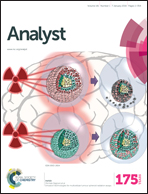A robust electrochemiluminescence immunoassay for carcinoembryonic antigen detection based on a microtiter plate as a bridge and Au@Pd nanorods as a peroxidase mimic†
Abstract
The common drawbacks of most traditional electrochemiluminescence (ECL) immunoassays are the strict storage conditions for the ECL electrode and the steric hindrance caused by bovine serum albumin and antigen. The strict storage conditions require that the modified electrode must be stored at 4 °C before measurement, which may cause the degradation of protein molecules and low reproducibility as the time goes by. The steric hindrance can hinder electron transfer between the electrode and the electrochemical active substance unable to transmit proteins on the electrode surface. The current study takes a 96-well microtiter plate (MTP) as a bridge for analyte pre-treatment and Au@Pd nanorods as a peroxidase mimic to assemble a simple and robust ECL immunoassay. Advantages of such assay include not only high sensitivity but also robust detection circumstance. We demonstrated the method by detecting carcinoembryonic antigen from human serum and obtained a good detection limit of 3 fg mL−1.


 Please wait while we load your content...
Please wait while we load your content...